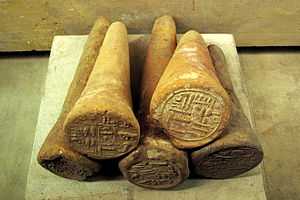Funerary cone
From Wikipedia, the free encyclopedia
Funerary cones (small cones made from clay) are an Ancient Egyptian artifact, almost exclusively in the Theban necropolis,[1] placed over the entrance of the chapel of a tomb. Early examples have been found from the Eleventh Dynasty, but are generally undecorated. During the New Kingdom, they were reduced in size and inscribed with the title and name of the tomb owner, often with a short prayer. The exact purpose of the cones is unknown.[2]
| Views of funerary cones | |||||||||
|---|---|---|---|---|---|---|---|---|---|
| |||||||||
See also
- Clay nail–(Mesopotamia)
External links
| Wikimedia Commons has media related to Funerary cone. |
Further reading
- Zenihiro, Kento (2009). The Complete Funerary Cones. Self-published. ISBN 978-4-89630-246-2.
References
- ↑ "Geographical distribution". Retrieved 2009-06-15.
- ↑ "Funerary Cones of the 18th Dynasty (from Thebes)". Retrieved 2008-04-20.
This article is issued from Wikipedia. The text is available under the Creative Commons Attribution/Share Alike; additional terms may apply for the media files.

